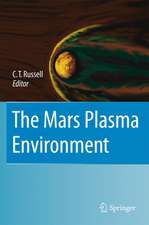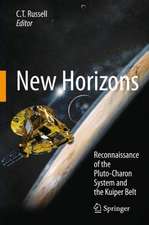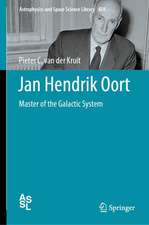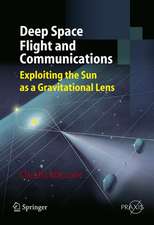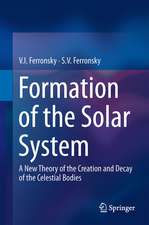Observing Photons in Space: A Guide to Experimental Space Astronomy: ISSI Scientific Report Series, cartea 9
Editat de Martin C. E. Huber, Anuschka Pauluhn, J. Len Culhane, J. Gethyn Timothy, Klaus Wilhelm, Alex Zehnderen Limba Engleză Hardback – 12 dec 2013
| Toate formatele și edițiile | Preț | Express |
|---|---|---|
| Paperback (1) | 819.89 lei 38-44 zile | |
| Springer – 17 sep 2016 | 819.89 lei 38-44 zile | |
| Hardback (1) | 972.30 lei 43-57 zile | |
| Springer – 12 dec 2013 | 972.30 lei 43-57 zile |
Preț: 972.30 lei
Preț vechi: 1185.73 lei
-18% Nou
Puncte Express: 1458
Preț estimativ în valută:
186.11€ • 202.22$ • 156.43£
186.11€ • 202.22$ • 156.43£
Carte tipărită la comandă
Livrare economică 21 aprilie-05 mai
Preluare comenzi: 021 569.72.76
Specificații
ISBN-13: 9781461478034
ISBN-10: 1461478030
Pagini: 748
Ilustrații: XVI, 731 p. 313 illus., 161 illus. in color.
Dimensiuni: 155 x 235 x 45 mm
Greutate: 1.22 kg
Ediția:2nd ed. 2013
Editura: Springer
Colecția Springer
Seria ISSI Scientific Report Series
Locul publicării:New York, NY, United States
ISBN-10: 1461478030
Pagini: 748
Ilustrații: XVI, 731 p. 313 illus., 161 illus. in color.
Dimensiuni: 155 x 235 x 45 mm
Greutate: 1.22 kg
Ediția:2nd ed. 2013
Editura: Springer
Colecția Springer
Seria ISSI Scientific Report Series
Locul publicării:New York, NY, United States
Public țintă
ResearchCuprins
From the Contents: Part I: Observing Photons in Space.- Part II: Energy and Wavelength Regions.- Part III: Techniques and Systems.- Part IV: Detectors.- Chapter 20: Detector Types Used in Space.- Part V: Polarimetry.- Part VI: General Techniques.- Part VII: Space Environment.
Notă biografică
Prof. Huber obtained his Ph.D. in 1963 under Prof. Ernst Miescher at the University of Basel with a dissertation on molecular spectroscopy. He was employed at the Harvard-Smithsonian Center for Astrophysics in Cambridge, Massachusetts where he worked in laboratory astrophysics and was responsible for the instrumentation and calibration of the Harvard instruments flown on the Orbiting Solar Observatory (OSO-6) and later on the Skylab space station (1973-74). After his return in 1973 to ETH Zurich he expanded his work in laboratory astrophysics to cover laser-excited plasmas, developed astronomical optics and participated in the SOHO mission as co-investigator on three experiments. Here, his interest lies in the radiometric inter-calibration of all the remote sensing-instruments on the spacecraft as well as in the measurement of the physical properties and chemical composition of the Solar Corona.
He headed ESA's Space Science Department from mid-1987 until mid-2000 and was ESA Science Advisor until 2001. He is an Associate of Harvard College Observatory, a member of the International Academy of Astronautics and of the Academia Europaea, and Honorary Member of the Swiss Physical Society. From 2003-2005 he was President of the European Physical Society. Currently he chairs the Swiss Commission for the Jungfraujoch Research Station of the Swiss Academy of Sciences (SCNAT), and is a member of the editorial board of the European journal "Astronomy and Astrophysics Review" and of the Board of Directors of the Europhysics Letters (EPL) Association.
He headed ESA's Space Science Department from mid-1987 until mid-2000 and was ESA Science Advisor until 2001. He is an Associate of Harvard College Observatory, a member of the International Academy of Astronautics and of the Academia Europaea, and Honorary Member of the Swiss Physical Society. From 2003-2005 he was President of the European Physical Society. Currently he chairs the Swiss Commission for the Jungfraujoch Research Station of the Swiss Academy of Sciences (SCNAT), and is a member of the editorial board of the European journal "Astronomy and Astrophysics Review" and of the Board of Directors of the Europhysics Letters (EPL) Association.
Textul de pe ultima copertă
An ideal resource for lecturers, this book provides a comprehensive review of experimental space astronomy. The number of astronomers whose knowledge and interest is concentrated on interpreting observations has grown substantially in the past decades; yet, the number of scientists who are familiar with and capable of dealing with instrumentation has dwindled. All of the authors of this work are leading and experienced experts and practitioners who have designed, built, tested, calibrated, launched and operated advanced observing equipment for space astronomy. This book also contains concise information on the history of the field, supported by appropriate references. Moreover, scientists working in other fields will be able to get a quick overview of the salient issues of observing photons in any one of the various energy, wavelength and frequency ranges accessible in space. This book was written with the intention to make it accessible to advanced undergraduate and graduate students.
Caracteristici
Covers all spectral domains used for observing astrophysical objects and phenomena in space Presents extensive details on general techniques used in space astronomy, such as calibration, cryogenics in space and laser aligned structures Discusses practical precautions to be used for astronomical space instrumentation as it relates to the launch and other implications of the space environment Includes supplementary material: sn.pub/extras














